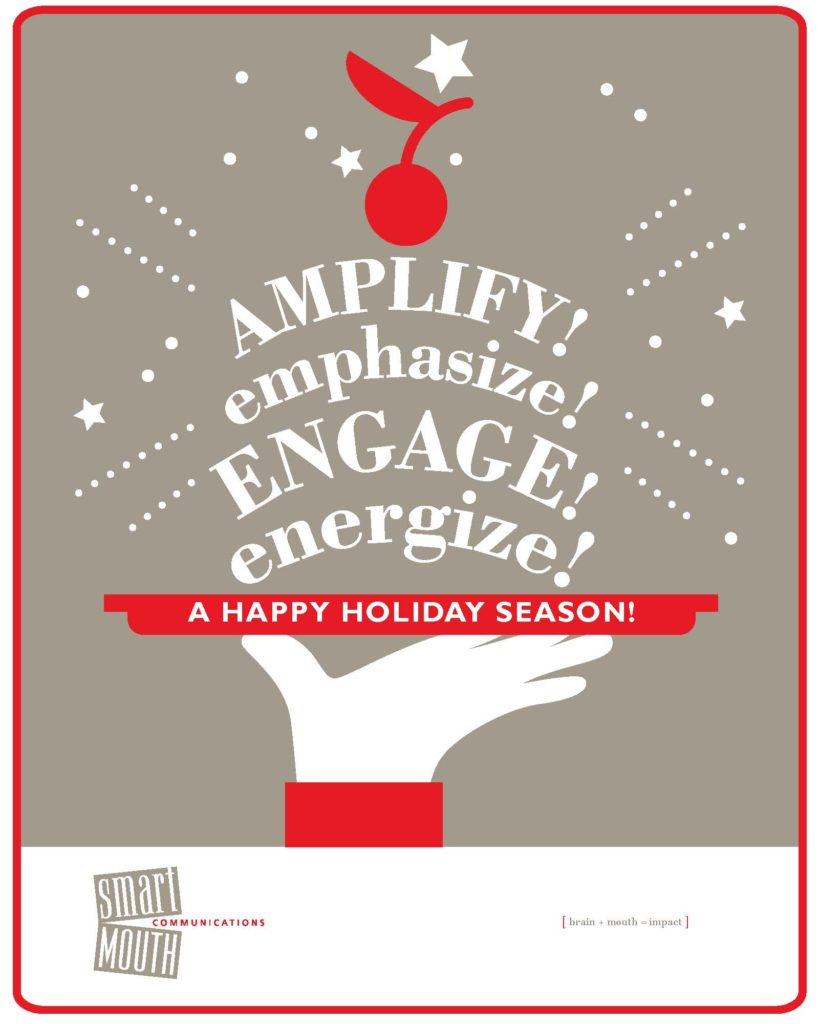SmartMouth Talks!
Co-Presenting Agreements
 Lately, I have worked with several clients who need to share the floor or take the stage with a colleague. Each speaker rehearsed and knew their section of the presentation but, as I observed and coached them, there’s a lot more to achieving a smooth, seamless co-presenting performance than just knowing your part.
Lately, I have worked with several clients who need to share the floor or take the stage with a colleague. Each speaker rehearsed and knew their section of the presentation but, as I observed and coached them, there’s a lot more to achieving a smooth, seamless co-presenting performance than just knowing your part.
Here are 3 important agreements you and your co-presenter should discuss and make in advance:
Avoid the awkwardness of not knowing where to put yourself or what to do when it’s not your turn. When your partner is speaking, you, in effect, become a member of the audience. You turn your attention to the speaker versus staring straight at the audience while you wait. You’ll want to choreograph yourselves so that each of you, when not speaking, takes a position that defers attention to the speaker and doesn’t interfere with the screen (if using visuals). Rehearse this in the presentation space itself or block it out in a space that’s comparable.
Transitioning from one speaker to the next requires forethought and finesse. Discuss and know ahead how you will pass the baton – and practice it – as if in a relay race. Please be more interesting, engaging and collegial than merely saying, “… and now Ashley will cover the budget.” Script in some banter or repartee, or make an astute comment to summarize the link between your and your co-presenter’s material. Or, if the presentation involves a consistent back and forth every few minutes or every few slides, then make sure Speaker A’s final sentence lines up with Speaker B’s opening sentence for each transition. Avoid the duplication of effort (and tedium!) of Speaker B feeling the need to say, “… so, as Speaker A just talked about …”
Interjecting is a relief to some, undermining to others. One of the most important agreements to discuss is whether each of you prefers for your co-presenter to interject comments or questions … or not. If you forget a chunk of your material, do you want your co-presenter to chime in? Would that be helpful or would it throw you off? Are you okay fielding spontaneous comments and questions from your co-presenter to help relieve nervousness and/or to make the presentation seem more casual and collaborative? Or would that make you lose your train of thought? When I work with a co-presenting team, I always think I know who will have which preference … and I am often wrong! You never know, so discuss and agree on this in advance.
There are so many benefits to co-presenting – the change in speakers is stimulating to the audience, presenters get to share the floor and Q&A with someone who has complementary expertise, and it can be more fun for the speakers and audience alike, to name just a few. Nevertheless, because it involves two (or more) people, there’s more material, more logistics and more dynamics to consider. Discussing and agreeing on the three points above is a great way to get ahead of the game.
Bottom line: Audiences are attending one presentation, not two, so treat it that way in your planning and delivery.
How to Go Without Notes
 When you prepare for a presentation, can you picture it in your mind’s eye? Do you know the elements of your opening or how you’re going to transition between your main points? Can you see it in your head, or do you need your notes?
When you prepare for a presentation, can you picture it in your mind’s eye? Do you know the elements of your opening or how you’re going to transition between your main points? Can you see it in your head, or do you need your notes?
A presentation isn’t as much a seamlessly flowing narrative as it is a deliberately well-constructed set of building blocks. For our discussion purposes here, let’s call those building blocks “chunks.” If you can chunk your material, then you have something modular, which is more easily abbreviated if your audience runs out of time and also easier for you to remember and deliver.
So what would the critical chunks of a presentation be and how would you construct them? I’m glad you asked!
First, you’ll need an opening chunk. This might include a question that stimulates the audience’s thoughts and connections to your topic. Or it might include a story that illustrates the importance of your topic. Or it might just be a simple introduction to the topic. Either way, your opening also needs to include a one-sentence focal point, in which you tell the audience what you want them to do (call to action) or to take away (impression, piece of knowledge) by the end.
Next, you’ll need to identify up to three key points. By “up to” I mean one, two or three points – and not three and a half, four or five. Yes, this means you’ll have to prioritize. You’ll be lucky if your audience can remember three, or two, or even one. So if you’re presenting with the intention and hope that your audience will retain what you say, then set a maximum of three key points. Each of your key points then becomes its own chunk, which means that with the opening chunk and up to three more, you have a maximum of four things to remember so far and you’re almost done!
Here are the ingredients of each of your “key point” chunks:
- A message statement that captures significance and/or conveys benefit for this section of your material.
- Some information points (data, detail, background) that support the message statement and that are prioritized and chosen based on your audience’s needs and interests.
- For good measure, and as a springboard to transition to your next chunk, each key point chunk should conclude with a reinforcement of the opening message statement.
Finally, your last chunk is your closing. Closing elements can include a recap of key point message statements; a story that illustrates the importance of your talk; and a circling back to your focal point to ensure that the audience knows what to do or think when they leave the room.
If you have the ability to picture five bullet points in your mind, you can see the chunks too. Try it and let us know how it goes!
Your First Presentation of the Year
 Most of us hit a personal reset button or two on the 1st of January. But even if you aren’t someone who makes specific resolutions, you probably still view the new year as a blank slate, a chance to start fresh.
Most of us hit a personal reset button or two on the 1st of January. But even if you aren’t someone who makes specific resolutions, you probably still view the new year as a blank slate, a chance to start fresh.10. You know this: Do your homework. Nothing drastic, just prepare ahead. If you think through your material rather than wing it, it will show and reflect well on you.
9. There’s no right or wrong, but there is better and worse. When in doubt, make decisions about your content, your visuals and the amount of time you’ll take based on your own experiences as an audience member. In other words, do unto others …
8. No one likes a windbag. Share the floor. Figure out ways to engage your audience and create opportunities for dialogue. Present, don’t broadcast.
7. Whatever you think is noticeable and distracting about you – your voice, hair, nose – it’s not. Unless you’re a paid spokesmodel, the audience isn’t paying attention to your specific physical features or your voice quality. They want to feel your confidence and hear your content.
6. Your content may be amazing, but your audience can only digest and retain some of it. Please prioritize all that great knowledge and information of yours so that you deliver something useful and memorable to your audience.
5. Present, the verb: to give something. Present, the noun: a gift. Figure out what you can give to your audience that would be a good gift – i.e. something new, useful, beneficial, valuable. Give them something good in exchange for their time and attention.
4. Your nerves are just adrenaline. They are your body’s way of surging positive energy for you to do a good job. Not to worry, studies show that nerves begin to dissipate after two minutes – that’s only 120 seconds.
3. Don’t dread your presentation, as if it’s some unpleasant obligation. Find your ambitious self and embrace your presentation as a great opportunity to advance – yourself, your organization or a goal. Go for it, don’t shrink from it.
2. Be organized: know your audience, know the lay of the land (number of people, room set-up, mic or no mic) as best you can, and know your desired outcome for the presentation. The first two help you envision what to expect. The third helps you know – if you prepare nothing else – how to set the audience’s expectations and where you need to get them by the end.
– and –
1. It’s all about them, it’s not about you. Your audience’s needs and experience supersede your own. Plan your presentation around them, not around yourself or your deep knowledge and expertise. Success is in the eye of the beholder, and that’s your audience. Make them #1.
Happy Holidays!
Grateful for your continued support of SmartMouth and wishing you the very best for 2019,


Speaking on a Panel: Prepare or Wing It?
 If there were ever an invitation to “wing it” in public speaking, it would be when you’re invited to speak on a panel.
If there were ever an invitation to “wing it” in public speaking, it would be when you’re invited to speak on a panel.
Or would it?
I think this is worth discussing …
For sure, the glory/work quotient of participating on a panel is high. On the glory side, panels are great public speaking opportunities. You’re usually matched with other notables in your field, sometimes with those more notable. You get great exposure and access to a new audience. And you get to share your best nuggets of genius without bearing full responsibility for filling the time.
On the work side, the heavy lifting is typically low. Except in cases where the panel is structured, and specific subsections of the topic are assigned, most panels tend to flow freely once introductions and perhaps opening remarks are made. They’re often moderated or facilitated, there are plenty of prompts to remind you exactly what to talk about, and there’s always someone to bail you out or fill an uncomfortable silence if you trail off, forget what you were about to say, or have only a few words to offer. Sweet!
So, prepare or wing it?
To answer this dilemma, I think you need to ask yourself why you said yes in the first place. What drew you? Was it a close colleague or friend who invited you? Was it the location of the event? (ProTip: Say yes to panels in Hawaii.) Maybe it was the opportunity to get in front of a particular audience? Or maybe you said yes because the topic is so near and dear to you, speaking about it on a panel would be a breeze, almost second-nature.
Your motivation for accepting the invitation informs but shouldn’t really affect your decision to prepare or not. Would it do you great harm not to prepare? Probably not. Would it benefit you greatly not to prepare? Probably not. In other words, there’s a decent probability that not preparing has a net neutral effect. You don’t really lose, you don’t really gain.
But let’s be honest here. Net neutral is not the typical effect you look to have in your career, is it? You spend a lot of time building – your network, your reputation, your expertise, your visibility. It’s probably fair to say that if you’ve said yes to a panel invitation, there’s some net gain you’ve identified. Therefore, at least some preparation is warranted.
To that end, let’s look at some ways to prepare that don’t take a lot of time but may pack a lot of punch:
Must-air points. Given the topic, there are likely points you do not want to forget to share with the audience. Think of it as a collection of your most important thoughts on the topic – your “greatest hits” – and jot them down in bullet point form.
Differentiators. Surely you have ideas, theories, discoveries, concepts or philosophies that are unique to you/your work and would distinguish you with the audience. Decide which ones you want to share and add them to your bullet points.
Stories. You most definitely have stories – examples, anecdotes, and/or drama-filled sagas – you can share. Pick your best ones and add those to the bullet points as well. Two tips on stories: 1) unless you identify and shape/practice them in advance, you’re unlikely to conjure up and tell the perfect story on the spot; and 2) stories need to be matched up with a point you’re making, in which the point becomes the punchline to the story.
The risks associated with winging it – rambling, hemming and hawing, searching your brain for the right things to say, losing your train of thought – are too great. Being prepared – with a definitive beginning and end to your points and good stories to illustrate those points – conveys confidence, command and polish. All you need is a few bullet points and you can post your next panel in the gain column!
The Golden Rule Rules

At the risk of putting myself out of business, I’m going to give you the only public speaking advice you’ll ever need …
The Golden Rule: Do unto others as you would have them do unto you. It’s the simple ethic of reciprocity. If you don’t like to be treated a certain way, then you certainly shouldn’t be treating others that way.
While the Golden Rule is a nice guiding principle for our daily interactions, it is an absolute go-to principle for decision-making when you’re preparing to speak in front of an audience. Keep in mind, you have been an audience member more often than you’ve been a speaker and so you have a keen sense of what works and what doesn’t.
Use your experiences and preferences as guidelines:
If you’re wondering how long to make your talk, think about how long you can sit through someone talking.
If you’re wondering whether to use PowerPoint and, if so, what should be on the slides, think about what types of visuals appeal to you.
If you’re wondering whether you should engage the audience during your presentation and how, think about whether and how you like to be engaged.
If you’re wondering whether you should use the first few minutes to introduce yourself and establish credibility, think about whether you appreciate that or prefer it to be done another way.
If you’re wondering whether, given the option, you should sit or stand to make your presentation, think about which position you find more appropriate or impressive.
If you’re wondering whether you should use personal stories or not, think about how the personal stories of others have left an impact or not.
See? You have all the answers you need just from your own experiences, and those experiences are quite valuable and informative. Don’t let them go to waste or be forgotten.
Being the speaker doesn’t suddenly propel you into a different stratosphere than your audience. You’re simply an audience member whose turn it is to get up and speak. So remember at the podium what it’s like in the seats and you’ll do great!
A Closer Look at Attention Spans
 There is considerable debate about attention spans and about the effects of the digital world and handheld devices. Interestingly enough, just a few decades ago, the debate focused on the effect that television was having on attention spans. Digital devices like smartphones and tablets are just the latest and greatest scapegoats. Whether they have or haven’t contributed to diminishing attention spans, it is certainly mind-boggling to realize that, with Twitter, full-bodied messages can be delivered in 140 characters or less.
There is considerable debate about attention spans and about the effects of the digital world and handheld devices. Interestingly enough, just a few decades ago, the debate focused on the effect that television was having on attention spans. Digital devices like smartphones and tablets are just the latest and greatest scapegoats. Whether they have or haven’t contributed to diminishing attention spans, it is certainly mind-boggling to realize that, with Twitter, full-bodied messages can be delivered in 140 characters or less.
The change in attention spans is often discussed in negative terms, as a deterioration in our ability to focus. But I think we have to ask ourselves, is this really a bad thing? I prefer to look at the phenomenon as a market disruption or correction that is forcing communications to adopt the often-touted corporate principles of leanness and efficiency. As companies try to increase engagement and productivity, improving communication—by cutting out waste—could be quite effective. Being brief and to the point may require a little extra effort, but it can accomplish a lot and save precious time.
Many studies have now measured adult attention spans—where they are and how they’ve changed over the years. There are reports suggesting that in just the last decade, the average adult attention span has shrunk from highs of twelve to eighteen minutes and to lows of three to five minutes, depending on the study’s focus and the environments of the participants. Some studies look at how long people can concentrate on a task; others look at their attentiveness while listening. Yet how long people can pay attention to a speaker depends on tremendous variables that can make it hard to measure: the comfort and conduciveness of the environment, the speaker’s voice quality and modulation, the actual content, whether there are effective visuals or good stories, what the objective is for the audience, and whether they understand that objective. The ability to focus is, after all, crucial to the achievement of an objective, so audience motivation levels can vary as well.
Holding the attention of an adult audience requires a tremendous amount of multitasking and careful advance planning. In other words, brevity—or perhaps we should call it efficiency and expediency—in communication takes discipline and planning. As the speaker, it’s up to you to do the hard work of organizing your thoughts and packaging your content for your audience, because their attention spans are what they are and they’re not growing!
(Excerpted in part from Jock Talk: 5 Communication Principles as Exemplified by Legends of the Sports World)
Never Mind Your Answers, Know Your Questions
 Q: Are you a presenter who likes to encourage audience engagement and discussion?
Q: Are you a presenter who likes to encourage audience engagement and discussion?
Q: Are you a presenter who worries about radio silence from your audience during Q&A?
Q: Are you a presenter who wants to know more about your audience when you’re in front of them?
If you answered yes to any or all of the above, then you are someone who needs to know your questions.
Presentation prep does not end with a well-organized deck, replete with clear points, well-contained information, some stories, and a call to action. Presentation prep also needs to include the questions you plan to ask your audience.
Here are 3 prompts for the types of questions you might need to prepare and know ahead of time:
Questions that encourage engagement, discussion and understanding.
Let’s say you are someone who does well with lots of audience engagement and active discussion during a presentation. How do you encourage that? Or let’s say you are someone who likes to stimulate discussion in order to get a feel for whether your audience is on the same page as you and understands/appreciates your points. How do you find out if they’re with you?
You’ll want to prepare ahead and develop some specific leading questions that get you to the discussion you want to conduct or to the understanding you’re hoping to achieve. Questions like “What do you think so far?” or “Tell me what you think the most compelling aspect of this proposal is so far?” or “Let me know who agrees or disagrees so far and why.”
Questions to prompt your audience during Q&A.
It’s time for Q&A. You announce to your audience, “We have about 10 minutes, I’m happy to take any questions you may have.” Radio silence. No hands, no voices. Now what do you do? Again, you will want to have prepared some questions ahead of time that might stimulate the kind of discussion you want to have.
This is where you might ask them, “Can someone tell me what their number one takeaway is from today’s talk?” (peer teachback!) or “Where are the holes in my proposal, what did I leave out?” (challenge me!) or “Is someone willing to volunteer and share their impression?” (potential exposure!)
Questions to help you get to know your audience.
Depending on the size of your audience, you can solicit input from them, either in the beginning or during your presentation, to get to know them better. You might know generally what they’re interested in, but there’s nothing like asking them on the spot, that day, what’s on their minds. Questions that elicit their personal interest or bias regarding your topic can be very helpful as you work through your material. The answers could well give you insights into things you should avoid or include.
Think about stating your topic and then asking the audience what it is about your topic that they would want you to be sure to cover. Or ask for a show of hands when you want to find out what proportion of the audience has had an experience you’re about to describe. Ask them to share their experience. Find out, on a more granular level, what they’re interested in regarding your topic.
It’s all risky. Knowing, not knowing. Asking, not asking. Put yourself out there, ask with sincerity and curiosity and then adapt/adjust accordingly. Your audience can be a presentation helper, not just a receptacle for your words.
Time’s Up
 Q: What’s up with long, tedious presentations?
Q: What’s up with long, tedious presentations?
A: Time’s up.
Be brief, people! Break away from the pack mentality of proving your worth with your word count and slide count, or the arbitrary convention of filling your allotted time. Leave your audiences wanting more!
No matter how much time you think you have, plan on less (I promise, no one will complain if you finish talking earlier than expected). When conference planners invite you to speak for an hour, don’t. They only do that because it’s easier to book eight speakers per day than 16. No audience can really hang on for an hour; in fact, we know that adults can only digest material for a maximum of 20 minutes. Even when the last 15 minutes are reserved for Q&A, those first 45 minutes are likely too long unless you are able to break up the time with Q&A throughout, videos, group discussions and exercises, or appealing/entertaining visuals.
Adult audiences also need a stimulus change to stay engaged. Without it, they zone out periodically. I recently led a group of female executives who met monthly to practice making different types of speeches and presentations, and they all admitted to zoning out at least once during each other’s talks, which, by the way, were capped at three minutes!
Audience attention is sharpest at the beginning and the end of a speech or presentation, so that makes openings and closings vitally important. In the middle, where the meat is, is where the audience zones out. The point is that it matters how you organize your material and guide your audience. And if it’s absolutely necessary to fill an hour-long time slot, be aware of about a 15-20 minute attention span limit. Break up the talk into sections, and keep each of those as brief as possible. Switch things up at 15-20 minute intervals as a way to restart the attention span clock: turn on the PowerPoint, turn it off, solicit Q&A at the end of each section, draw or write on a white board, show a video. Choreograph the time with your audience’s experience and attention spans in mind.
It’s all about them, so make some judgment calls about what will best suit your audience, including the length and structure of your presentation.
(Excerpted in part from Jock Talk: 5 Communication Principles as Exemplified by Legends of the Sports World)
You’re Not Special
You’re not special. But don’t worry, I’m not special either.
Why do I say that? Because no matter what we do – how well we prepare or how engaging we are – we will lose our audience at one point or another during our presentation. It’s just not realistic to assume that everyone in the audience will be able to hang on for every word, every slide, or even every key point of a talk.
 People check out. It’s a fact. And it’s not (necessarily) your fault. It’s the ebb and flow of the human attention span and the unavoidable distractions – both tangible (messages coming through on devices) and intangible (daydreaming, exhaustion, or randomly occurring thoughts) – that are to blame.
People check out. It’s a fact. And it’s not (necessarily) your fault. It’s the ebb and flow of the human attention span and the unavoidable distractions – both tangible (messages coming through on devices) and intangible (daydreaming, exhaustion, or randomly occurring thoughts) – that are to blame.
No matter how diligently you prepare or rehearse, it’s still not an insurance policy against audience members checking out during your presentation. As much as you plan a presentation for audiences to hear your every word, they won’t. They’ll drift off. You’re not special, and neither am I. We have to work to grab and hold their attention and we have to plan for their lapses in attention.
So, how do we do that? Below are 3 ways you can provide a helping hand to your audience members:
Be Brief
Unless your topic or audience call for a deep, thorough download, be as succinct as possible. Every time. In fact, I would advise you to think about whether people are in the room on their own free will (in which case you have some leeway) or out of obligation (in which case brevity is urgent). This will help you gauge how much time and detail you will use, and it will be better suited to your audience.
Know, don’t guess, how long your presentation is. Rehearse a few times and time yourself. This way, you’ll know if you need to make adjustments or cut some material. You’ll also be able to let your audience know what they’re in for from the start. If you can tell them how long your talk is, they’ll be better able to calibrate their own attention span – e.g. “oh, this is only 20 minutes? I can hang on for 20 minutes.”
Use Signposts
On your slides and as you are speaking, give your audience cues and clues as to where you are in your talk. Trust me, they need this. (You’ve needed it, haven’t you? Think about your own experiences sitting through presentations … I’m guessing there are at least a few instances when you would have liked some cues or clues!) Guide them.
Visually, you can help your audience by including a progress bar in your slides, so that your audience can track where you are in your presentation. Or, if you have a small deck, you can include a countdown – e.g. 1 of 12, 2 of 12, etc. Or, if you have, let’s say, three main sections that you told your audience you would be covering, you can let them know where you are by including the name or keyword for each section in the lower right corner. In fact, all of these visual cues are best situated in the lower right corner of your slides.
Verbally, you can keep your audience tracking by narrating where you are and what you’re doing. Some examples of this include: telling the audience how long your talk will be, letting them know when you’re digressing to share a relevant story, letting them know when the story is over and you’re returning to your point, alerting them whenever you’re transitioning from one section of your presentation to another, and (everyone’s favorite) announcing the conclusion.
Be Dramatic
Use the pregnant pause. Stop and stand in the middle of the stage. Animate or “act out” what you’re talking about. For example, if you say the number 4, hold up 4 fingers. Or if you say, “fast forward a few years,” roll your forearms, one over the other, to show motion. Or if you’re talking about something meaningful, touch your heart.
If “the show” moves along and there’s more to look at than just your visuals, people might hang in there with you better and longer. Before you resist and say I can’t do that, let me offer this: What might feel like theatrics to you will merely look like good delivery energy to your audience.
In a perfect world, speakers would be efficient enough with their words that audiences would be able to hang on every one of them. But as we all know, that’s not the case. Even the most efficient speakers and the best audiences have lapses – no matter how good or how special the speakers are! The best you can do to hold onto your audience’s attention is to take them by the hand and guide them through your presentation. The rest is up to them.



